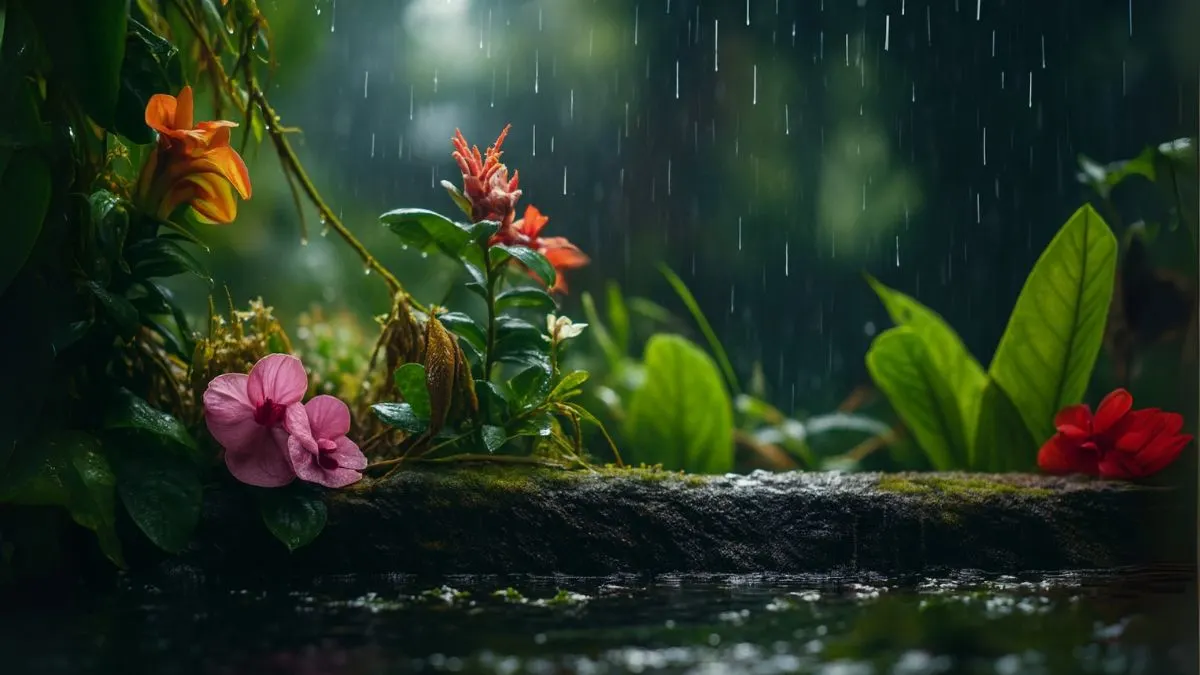There’s something deeply comforting about the sound of raindrops on leaves. The rainy season is a magical time when the joy of growing plants comes to life. For gardeners, this is not just about water falling from the sky. It’s about renewal, growth, and the earth breathing again.
As I stand near my garden during monsoons, I often realize that rainy days are more than water for the plants. They are reminders of nature’s rhythm—a soft serenade that rejuvenates everything it touches.
The Science Behind Rainfall and Plant Growth

- Natural Irrigation: Rainfall delivers clean, mineral-rich water straight to the roots. Unlike tap water, it’s free from chemicals like chlorine, which makes it healthier for plants.
- Nitrogen Boost: Rainwater carries dissolved nitrogen from the atmosphere. This natural fertilizer helps plants grow greener, stronger, and faster.
- Soil Enrichment: When rain penetrates deep into the ground, it replenishes underground water tables and helps balance soil pH, giving plants a better growing environment.
Rainfall as Therapy: The Joy of Gardening in Monsoon
For many, gardening is more than a hobby—it’s therapy. Rainy days are more than water for the plants; they are moments when even gardeners feel revived. Watching droplets form on a leaf or hearing the pitter-patter against petals brings calmness.
Personally, I find that during monsoon, my garden feels alive in ways no watering can replicate. It’s as if every plant is dancing, celebrating, and whispering gratitude. Truly, the rainy season is a magical time when the joy of growing plants comes to life.
Also Read: How You Can Add Syngonium to Your Home
Best Plants to Grow During Rainy Season
- Indoor Prayer Plant: Perfect for homes in Canada and the USA, this plant thrives in humidity. Rainy days help maintain moisture levels, keeping its patterned leaves fresh.
- Lupin Flowers: If you want ornamental beauty, How to Plant Lupin Seeds becomes easier in moist soil. They establish roots quickly when rainfall is consistent.
- Guduchi Plant: Valued in traditional medicine, Guduchi absorbs the natural minerals in rainwater, making its stems even more potent.
- Hawthorn Plants: Loved for their benefits, these shrubs grow best when the rainy season nourishes their roots. They also attract birds and pollinators.
- Nutrient-Rich Wild Greens: Monsoons are the perfect time to grow this iron-rich wild vegetable. Rain makes the soil fertile, helping them sprout without much effort.
Capturing the Poetry of Rainy Days
Rain is not just science—it’s art. Gardeners and poets alike capture the beauty and poetry of rainy days through stories, pictures, and journals. Watching your daffodils bend under raindrops or your redbud tree shimmer in the mist feels like living in a painting.
Try keeping a gardening journal during monsoon. Note down how plants respond, the changes in soil, and even the emotions you feel. It makes the journey of growing plants more meaningful.
Practical Tips for Rainy Season Gardening
Task |
Why It Matters |
Tip |
Drainage |
Prevents waterlogging |
Use raised beds or pots with holes |
Mulching |
Conserves moisture |
Add organic mulch to control weeds |
Pest Control |
Rain invites snails/slugs |
Use natural repellents like neem oil |
Fertilizer |
Rain already adds nitrogen |
Reduce chemical fertilizer use |
Sunlight Balance |
Some days are cloudy |
Place pots in semi-open areas |
Also Read: The Fascinating Role of Plant Shoots in Growth
How Rainfall Ignites the Joy of Growing Plants Globally
Whether it’s a backyard in Toronto or a balcony in New York, rainfall transforms the gardening experience. Urban gardeners cherish monsoon because it reduces dependency on hoses and sprinklers. In rural areas, farmers and home-growers alike celebrate rain as the gift that makes harvests possible.
Rain is more than a weather event—it’s a celebration of life. So, this season, step outside during a drizzle. Listen, watch, and breathe in the freshness. Let your garden remind you that the rainy season is a magical time when the joy of growing plants comes to life. And don’t forget to capture the beauty and poetry of rainy days—because in those small, rain-kissed moments, nature sings its sweetest serenade.






